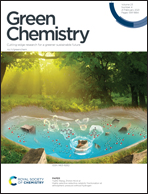Formaldehyde in multicomponent reactions
Abstract
Acting as a C1 building block, formaldehyde is of great significance in organic synthesis. It is also a key feedstock in several industries, such as resins, polymers, adhesives, and paints. Multicomponent reactions (MCRs) have emerged as applicable tools in organic reactions because efficient MCRs allow the creation of several chemical bonds in one sequence without labor-consuming reaction condition optimization and work-up procedures, thus minimizing waste production, cost, and labor consumption. In this review, we mainly focus on the recent advances in the contribution of formaldehyde, which was herein used as a versatile C1 building block to produce either acyclic or heterocyclic molecules via MCRs with the potential to be more sustainable than lengthier alternatives and used as a divergent chemical thanks to its excellent reactivity, flexibility, and hydrophilicity.

- This article is part of the themed collection: Green Chemistry Reviews


 Please wait while we load your content...
Please wait while we load your content...